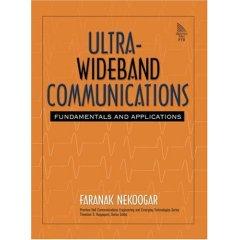| 2020ok Directory of FREE Online Books and FREE eBooks |
Free eBooks > Computers & Internet > Programming > Introductory & Beginning > General > Ultra Wideband Communications Fundamentals and Applications Aug 2005
Ultra Wideband Communications Fundamentals and Applications Aug 2005by Faranak Nekoogar  Download Book If you are the author or the publisher, and would like to link to your site here, please contact us. About Book Book Description This book introduces UWB communications systems in simple and easy to understand language. It covers the fundamentals for short pulse generation and propagation, regulatory issues, UWB interference concerns, and the applications and potential target markets. It offers a comprehensive background to UWB technology, short pulse generation, UWB antenna concepts, UWB modulation and multiple access techniques as well as UWB applications. This book is for self-study by individuals new to the field of UWB communications. The simple language and full coverage of the technology makes this book a perfect reference for non-technical readers as well as a good study aide for undergraduate students for understanding more technical text books in the field. From the Back Cover The Easy-to-Understand, Up-to-the-Minute Guide to UWB Technologies, Applications, and Markets Ultra-wideband's exceptional capacity and power characteristics make it one of this generation's most exciting technologies. From wireless communications to entertainment, and from the automotive industry to homeland security, UWB is poised to revolutionize an extraordinary array of applications. Now, one of the field's leading experts presents the most accessible and up-to-date UWB guidebook ever written. Dr. Faranak Nekoogar explains UWB principles and technologies simply and clearly, addressing key issues such as pulse generation, modulation, multiple access techniques, and interference. In addition, she presents a complete market analysis--identifying the most promising applications, initial and future markets, and regulatory trends. Ultra-Wideband Communications: Fundamentals and Applications will be indispensable for everyone interested in UWB technology, regardless of their radio frequency experience: engineers, managers, marketers, analysts, purchasing agents, business strategists, journalists, and students alike. Inside you will find
About the Author Faranak Nekoogar, Ph.D., is coauthor of From ASICs to SOCs: A Practical Approach, published by Prentice Hall (2003). She has worked for many years researching UWB topics in the Department of Applied Science at University of California, Davis. Faranak has published several patent applications and technical papers in the following areas of UWB research: multiple-access techniques, channel estimation, synchronization, and secure wireless sensor networks using UWB radios. She currently conducts research on UWB-RFIDs at Lawrence Livermore National Laboratory. She also has several years of industry experience in functional and timing verification of application-specific integrated circuits and systems-on-a-chip. Excerpt. © Reprinted by permission. All rights reserved. Ultra-wideband (UWB) radios are expected to play a revolutionary role in the future of wireless communications systems. The great interest in UWB communications was sparked by FCC rulings in February 2002 that authorized the unlicensed commercial deployment of UWB technology under a strict power control in 7500 MHz of spectrum. This fast-emerging technology uses extremely narrow and low-power RF pulses to transmit and receive information. Using short-duration pulses as the basic building block of communication results in exceptionally attractive features as well as unique technical challenges.This book provides a comprehensive introduction to UWB communications systems in a simple and easy-to-understand language. It covers the fundamentals of short pulse generation and propagation, regulatory issues, concerns about UWB interference, and UWB applications and potential target markets. The following items characterize the book.
The simple language and full coverage of the technology makes this book a complete reference for individuals new to the field of UWB communications and for nontechnical readers, as well as a good study aid for undergraduate students so that they can better understand more technical textbooks. In addition, managers, marketers, analysts, purchasing agents, journalists, continuing education students, and engineers new to the field can all benefit from reading this book. The book is organized in the following fashion:
Related Free eBooks
| Related Tags |












SEND A COMMENT
PLEASE READ: All comments must be approved before appearing in the thread; time and space constraints prevent all comments from appearing. We will only approve comments that are directly related to the article, use appropriate language and are not attacking the comments of others.